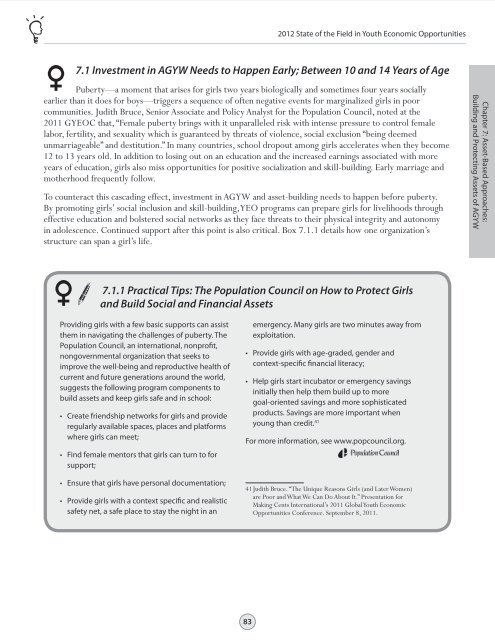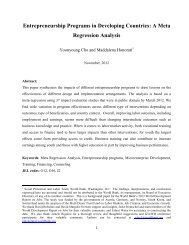STATE OF THE FIELD IN YOUTH ECONOMIC OPPORTUNITIES
STATE OF THE FIELD IN YOUTH ECONOMIC OPPORTUNITIES
STATE OF THE FIELD IN YOUTH ECONOMIC OPPORTUNITIES
Create successful ePaper yourself
Turn your PDF publications into a flip-book with our unique Google optimized e-Paper software.
Table of Contents<br />
Chapter 1 Chapter 2 Chapter 3 Chapter 4 Chapter 5 Chapter 6 Chapter 7 Chapter 8<br />
Chapter 9<br />
Chapter 10 Chapter 11 Chapter 12 Chapter 13 Chapter 14 Chapter 15 Annexes<br />
2012 State of the Field in Youth Economic Opportunities<br />
7.1 Investment in AGYW Needs to Happen Early; Between 10 and 14 Years of Age<br />
Puberty—a moment that arises for girls two years biologically and sometimes four years socially<br />
earlier than it does for boys—triggers a sequence of often negative events for marginalized girls in poor<br />
communities. Judith Bruce, Senior Associate and Policy Analyst for the Population Council, noted at the<br />
2011 GYEOC that, “Female puberty brings with it unparalleled risk with intense pressure to control female<br />
labor, fertility, and sexuality which is guaranteed by threats of violence, social exclusion “being deemed<br />
unmarriageable” and destitution.” In many countries, school dropout among girls accelerates when they become<br />
12 to 13 years old. In addition to losing out on an education and the increased earnings associated with more<br />
years of education, girls also miss opportunities for positive socialization and skill-building. Early marriage and<br />
motherhood frequently follow.<br />
To counteract this cascading effect, investment in AGYW and asset-building needs to happen before puberty.<br />
By promoting girls’ social inclusion and skill-building, YEO programs can prepare girls for livelihoods through<br />
effective education and bolstered social networks as they face threats to their physical integrity and autonomy<br />
in adolescence. Continued support after this point is also critical. Box 7.1.1 details how one organization’s<br />
structure can span a girl’s life.<br />
Chapter 7: Asset-Based Approaches:<br />
Building and Protecting Assets of AGYW<br />
7.1.1 Practical Tips: The Population Council on How to Protect Girls<br />
and Build Social and Financial Assets<br />
Providing girls with a few basic supports can assist<br />
them in navigating the challenges of puberty. The<br />
Population Council, an international, nonprofit,<br />
nongovernmental organization that seeks to<br />
improve the well-being and reproductive health of<br />
current and future generations around the world,<br />
suggests the following program components to<br />
build assets and keep girls safe and in school:<br />
• Create friendship networks for girls and provide<br />
regularly available spaces, places and platforms<br />
where girls can meet;<br />
• Find female mentors that girls can turn to for<br />
support;<br />
emergency. Many girls are two minutes away from<br />
exploitation.<br />
• Provide girls with age-graded, gender and<br />
context-specific financial literacy;<br />
• Help girls start incubator or emergency savings<br />
initially then help them build up to more<br />
goal-oriented savings and more sophisticated<br />
products. Savings are more important when<br />
young than credit. 41<br />
For more information, see www.popcouncil.org.<br />
• Ensure that girls have personal documentation;<br />
• Provide girls with a context specific and realistic<br />
safety net, a safe place to stay the night in an<br />
41 Judith Bruce. “The Unique Reasons Girls (and Later Women)<br />
are Poor and What We Can Do About It.” Presentation for<br />
Making Cents International’s 2011 Global Youth Economic<br />
Opportunities Conference. September 8, 2011.<br />
83

















